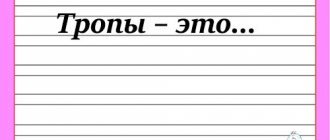3.9
Average rating: 3.9
Total ratings received: 419.
3.9
Average rating: 3.9
Total ratings received: 419.
Lexical means of expression are basic. They include various trails. This article will illustrate visual means in literature with examples.
Definition
Fine-expressive means of language (tropes) are words and expressions that are used figuratively.
Imagery is the main feature of visual and expressive means.
Translated from Greek, trope means image.
The list of figurative and expressive means of the Russian language includes epithets, metaphors, personification, comparisons, metonymy, synecdoche, hyperbole, grotesque, litotes, periphrases, allegories, irony, allusions, reminiscences.
Rice. 1. List of tropes
Functions
Artistic and expressive means help make speech bright and emotional. They help draw attention to the statement. In literary texts, means of expression help in revealing the author's intention and the author's attitude to the statement. They help create the desired image. They are also necessary in order to convey a specific thought most accurately and subtly.
In addition, there is a more colorful transmission of information, since shades of meaning are used in the description.
The set of means of expression helps in conveying the author's style.
Brief information about each trail
- epithet - a figurative, colorful, expressive definition, which is based on a hidden comparison (lemon light);
- metaphor - a word or expression that is used in a figurative meaning based on the similarity of two objects or phenomena according to some characteristic (color, volume, shape, etc.) (the abyss of grief);
- personification is a type of metaphor based on the transfer of human properties to inanimate objects (the guitar sang);
- comparison - a comparison of two objects, concepts or states that have a common attribute (words burn like flames);
- metonymy - the transfer of properties of one object to another based on the contiguity of two concepts (read Pushkin);
- synecdoche - techniques based on the transfer of meaning according to a quantitative characteristic or on the transfer of the name of a whole by the name of its part and vice versa (And it was heard until dawn how the Frenchman rejoiced);
- hyperbole - artistic exaggeration of the properties of objects (scared to death);
- grotesque - a bizarre mixture in the image of the real and the fantastic, the beautiful and the ugly, the tragic and the comic (a nose walks along the avenue);
- litotes – belittling the properties of an object (a little boy);
- periphrasis - a phrase that is used instead of any word or phrase (king of beasts);
- allegory - allegories (walked like a bear);
- irony - subtle ridicule, the use of a word in the opposite sense (“Break off, smart one, are you delusional, head?”);
- allusion - a hint at a certain fact or circumstance that is often not understood by many (“Such a fatherland is such smoke really so pleasant” V.V. Mayakovsky - a reference to “Woe from Wit” by A.S. Griboyedov);
- reminiscence - reproduction in the text of a familiar construction or phrase from another work (“I loved you. Love still (perhaps just pain) drills into my brain.” In the poem, I. A. Brodsky refers the reader to the poem by A. S. Pushkin).
Fine and expressive means of language
| Item: | Russian language |
| Kind of work: | Essay |
| Language: | Russian |
| Date added: | 27.11.2019 |
- This type of work is not scientific work, it is not a finished work!
- This type of work is a finished result of processing, structuring and formatting collected information intended for use as a source of material for independent preparation of educational work.
If you have a hard time understanding this topic, write to me on WhatsApp, we’ll look into your topic, agree on a deadline, and I’ll help you!
Using this link you can find abstracts on the Russian language on any topic and see how they are written:
| Many ready-made topics for essays on the Russian language |
Check out these similar threads, they might be useful to you:
| Dictionaries of the Russian language and their scope of use |
| M.V. Lomonosov's contribution to the study of the Russian language |
| Structural classification of unions and reflection of composite unions in it |
| The use of jargon in the speech of modern TV presenters |
Introduction:
Figurativeness is the quality of speech that makes it visual; it is based not only on conceptual, but also on figurative information (visual, auditory, olfactory, gustatory, tactile). Figurative speech is perceived faster, evokes emotions and is closely related to evaluation. Therefore, it is better retained in memory.
Expressiveness is the quality of speech that attracts the listener’s attention to it and forces the listener to fixate on it. Expressive speech is able to “stay afloat” in the flow of information. Expressive means of language allow the author to highlight the main thing in the message and thereby facilitate its perception.
Concept of expressiveness
Our experience of speech leaves no room for doubt that the structure of speech, its properties and characteristics can awaken people's thoughts and feelings, can maintain keen attention and arouse interest in what is said or written. These features of the speech structure give reason to call it expressive.
The expressiveness of speech refers to those features of its structure that maintain the attention and interest of the listener or reader; Accordingly, speech that has these features will be called expressive. A typology of expressiveness, unfortunately, is not yet available. For now, we can only be cautious about its basics. One of the reasons is the communication situation. The expressiveness of a teacher's speech obviously does not coincide with the expressiveness of a political speaker.
The second basis, which is clearer, is the structural areas of language: there may be spoken expressiveness, accentological expressiveness, lexical and word-formative expressiveness. The quality of expressiveness can be conveyed by speech through language, which are included in various areas of the linguistic structure. But more on that later. In addition, we will not forget that the structural organization of speech has its own expressive possibilities, including in this concept the structure of a paragraph, the structure of a chapter or section of an oral presentation, as well as the structure of the entire text.
Apparently, the following general consideration is true: everything that semantically or formally stands out against the background of the general habitual speech is expressive in speech.
Fine-expressive means of language are techniques that make speech visual, figurative and design it in a special way, attracting attention to it.
The visual side of oratorical speech plays the most important, fundamental role. Jean-Jacques Rousseau argued that "the most persuasive speeches are undoubtedly those that contain the most images." This means that the strength of the argumentation of speech directly depends on its imagery. The audience believes the speaker due to the fact that he reinforces his arguments with imagery, depicting the objects of the external world being discussed and his inner mood.
The sphere of natural evidence, when, in particular, references to eyewitnesses are used (they can be those who are convinced themselves), needs vivid pictures of the external situation. In this case, it is advisable to use such visual means as attribution, hyponymization, synonymization, as well as tropes and amplifications - metaphors, metonymies, comparisons. The first group of means gives a vivid, but obvious and easily observable picture of the world. Paths, on the other hand, contribute to the depiction of more subtle details and details that are not so obvious and therefore less accessible to observation. Natural evidence can also be supported by diagrammatic figures capable of depicting phenomena of the external world.
Logical proofs also necessitate the widespread use of means associated with external representation. These are, for example, reasoning by analogy or inductive arguments, which are not absolute evidence, having only a probabilistic nature. Hence the importance of pictures of possible external situations. Syllogisms will, to a greater extent, require from the speaker such visual means that can convey his inner mood, his train of thoughts, and can demonstrate concentration.
The depiction of the surrounding world should also be used to support arguments for pathos and ethos. Thus, with maximum depiction, objects of threat and promise, objects of empathy and rejection should appear before the audience. Detailed comparisons are especially predisposed to the implementation of ethical arguments, which concentrate and further affirm the thought shared by the audience.
Figures that can depict a person’s inner world are of great importance for persuasive speech. In order to persuade the audience to make the necessary decision, the speaker needs to “infect” it with his emotions. The confident emotional mood of a speaker using ethical or sensual arguments is conveyed with the help of addition figures - such as anaphora, ring, double verbal repetition.
Confidence growing to a very high degree can be conveyed by tropes and amplifications based on contrast - gradation, correction, antithesis, antiphrase.
The invariability of assessments, the sequence of thoughts that accompany logical arguments are realized with the help of such figures as epanode, period, zeugma. There are also cases when the speaker needs to temporarily hide his communicative attitude from the audience, portray uncertainty, confusion, etc. In this case, one should use figures of placement and rearrangement - parcellation, parenthesis, inversion.
Language has special and non-special means of enhancing visualization and expressiveness.
Special means include verbal figures and figures of thought. Figures of thought include tropes and amplifications.
Word figures
Verbal figures are unusual figures of speech that clearly express the emotional state of the speaker.
A lasting, extended feeling is expressed by repetitions of words, an intermittent, fluctuating feeling is expressed by verbal interruptions (interruptions). Haste - omission of words (ellipsis).
Various units may be repeated: parts of words, function and full-meaning words, syntactic units. They can be located either arbitrarily or symmetrically. All addition figures convey the stability of the emotional background, regardless of its color. Therefore, they are used both for praise and humiliation.
The main function of these verbal figures is to demonstrate a strong, lasting feeling.
Anaphora is the repetition of words at the beginning of adjacent segments of speech. The meaning of anaphora is to demonstrate a confident emotional mood, conveying an optimistic mood. This is a favorite figure of political figures who use quite lengthy anaphors, each paragraph or each sentence starting with the same words.
“It’s time to remove the amber, it’s time to change the dictionary, it’s time to extinguish the door lamp...” (M. Tsvetaeva).
Epiphora - repetitions of words at the ends of adjacent segments: international roaming, automatic roaming. Epiphora also conveys confidence, but focuses attention on the consequence, conveys a certain inevitability and therefore is less often painted in light colors.
“And people are disgusting to me, and the house is disgusting to me, and the walls are disgusting” A. Ostrovsky.
Compositional junction - repetitions of words at the boundaries of adjacent segments: only here, here and nowhere else. Conveying confidence, this figure at the same time depicts the external flow of events: their slowness, cause-and-effect conditionality. Therefore, it is more appropriate in descriptive texts than in speeches.
My homeland did everything for me. my homeland taught me, raised me, gave me a start in life. a life I'm proud of.
The junction is also appropriate in reasoning texts, when it is necessary to emphasize the course of cause-and-effect relationships.
A ring is a segment of speech that begins and ends the same. Like the junction, the ring is ideal for describing external events. It conveys a closed movement in a circle, as well as a return of thought to something inevitable.
Peter the Great deliberately chose shock therapy to liberate Russia from the legacy of Byzantium, and his today's successors also have no choice but shock therapy (E. Gellner).
By placing the phrase “shock therapy” at the beginning (though not absolute) and the end of the sentence, the author demonstrates the inevitability of shock therapy.
Chiasmus is a figure in which two elements are repeated, and when repeated they are arranged in the reverse order:
We do not live to eat, but we eat to live.
Chiasmus is often strengthened by antithesis.
Polyunion - excessive repetitions of the conjunction “and”: The sound, the color, and even the quality of the screens in the new Moscow cinemas are not at all what they were before. Polyunion, along with confidence, conveys slowness of action. In the above sentence, a slight slowdown in speech conveys a feeling of solidity and good quality. The sound, light, and quality of screens in new Moscow cinemas have changed.
And thunder did not strike, and the sky did not fall to the ground, and the rivers did not overflow from such grief!
Asymmetrical repetitions of words:
Double repetition (gemination) focuses attention on the object, which is important for advertising slogans:
Invite, Invite - just add water!
Homeology - repetition of similar endings or morphemes:
SUPER discount on a SUPER phone!
Syntactic parallelism is the repetition of the same type of syntactic units in the same type of syntactic positions: You - to me, I - to you. Often syntactic parallelism is accompanied by an antithesis: a strong governor - great rights, a weak governor - no rights; a public politician - the republic is known in the country, a non-public politician - no one knows about it (V. Ryzhkov).
Decrease figures are based, on the contrary, on the omission of some units. These figures give energy to speech, the speaker’s determination to move from words to action. These figures are very often used in slogans and newspaper headlines.
Ellipsis is the omission of implied elements within a sentence, usually the omission of a predicate:
Who goes where, and I’m off to the savings bank!
Ellipsis is most typical for slogans, in particular labor mottos, which will be discussed in more detail in the corresponding section.
Broken utterance - incompleteness of a phrase:
The authorities have not kept so many of their promises.
Skipping the beginning of a phrase: plus good quality. The figure is used almost exclusively in newspaper headlines and advertising copy.
Non-union - absence of unions when listing. Makes the text dynamic and warns about information compression.
Zeugma is a series of syntactically homogeneous constructions, one of which has a main member, and the other is missing: Meanwhile, it is absolutely clear that a politician should be involved in politics, an entrepreneur with his business, an official with the art of bureaucracy, a scientist with science (Yu.P. Senokosov).
Figures of placement and rearrangement are based on breaking the usual order of elements that usually stand next to each other. Such figures demonstrate a state of instability, hesitation, and a change in mood due to the information just received.
Inversion is a violation of the usual word order. The predicate comes before the subject to highlight new information in the sentence.
the verdict of fate has come true. And with inversion, words are arranged in a different order than established by grammatical rules.
Fate has reached its conclusion. M. Yu. Lermontov
Parcellation is the division of the original statement into two intonationally separate segments: “this year was dark from melted snow. noisy from the barking of guard dogs. bitter from coffee and old records.” S. Dovlatov.
Parentesis is the division of the original statement into two parts with an insertion in parentheses or a dash placed between them.
Phonetic figures occupy a special place in the system of verbal figures. There are two such figures:
Alliteration is the repetition of consonant sounds and assonance is the repetition of vowel sounds. Often both figures are used simultaneously. But they perform different functions: to create the effect of onomatopoeia (sounding speech resembles the sounds of the phenomenon being described: the rustling of a silk cord); cause associations with some ideas, sensations, emotions due to sound similarity with words denoting these phenomena, sensations, emotions (the sad tone of the sound “u”, supported by the presence of words such as dull, boring, sad) and the pronunciation of individual sounds, correlated with a certain mental state (“aggression” of the “r” sound). A roar of thunder rolled across the blue sky. S. Ya. Marshak
Graphic figures are similar to sound ones. They are perceived visually (palindrome - the same reading from left to right and right to left: fashion house and acrostic - the first letters of the lines form a word).
Trails
Trope (from ancient Greek τρόπος - turnover) - words and expressions used in a figurative sense, when the attribute of one object is transferred to another, in order to achieve artistic expressiveness in speech. The basis of any trope is a comparison of objects and phenomena.
Tropes are present in various works and are used by most writers and poets. Paths are studied by the science of semasiology and its subsection - poetic semasiology.
Metaphor is one of the most powerful rhetorical devices designed to have lasting impact. Metaphors are well remembered, stored in memory and become the building blocks from which a picture of the world is formed. Such political metaphorical phrases as iron curtain, capitalist shark, evil empire are widely known. For Soviet labor propaganda, such a political-economic metaphor as building a new life was of great importance. The metaphor varied, but the image of construction, construction, construction site remained and was subsequently used in the formula “perestroika.” From such metaphors, as they are repeated or unfolded, allegories and emblems grow. In articles and speeches, extended metaphors play a special role. Epithet, personification, oxymoron, antithesis can be considered as a type of metaphor.
Empty skies transparent glass.
(A.A. Akhmatova)
An oxymoron is a combination of words with contrasting meanings that create a new concept or idea. This is a combination of logically incompatible concepts that sharply contradict in meaning and are mutually exclusive. This technique prepares the reader to perceive contradictory, complex phenomena, often the struggle of opposites.
The sad fun continued.
Metonymy (renaming) is the replacement of a word or concept with another word that has a causal (temporal, spatial, material) connection with the first.
Types of metonymy:
- mentioning the name of the author instead of his works: “I read Apuleius willingly, but did not read Cicero,” “Belinsky and Gogol will carry away from the market”;
- the name of the weapon instead of the action: “His feather breathes with love”;
- the name of a place, a country instead of the people and people located or living there: “No, my Moscow did not go to him with a guilty head”;
- the name containing instead of the content: “The hissing of foamy glasses”;
- the name of the material from which the thing is made instead of the thing itself: “Porcelain and bronze on the table”;
- the name of one sign, attribute instead of a person, object or phenomenon: “All flags will visit us.”
- Violent Rome rejoices (M.Yu. Lermontov);
- Synecdoche is a type of metonymy in which 1) instead of the plural, the singular is used; 2) instead of the whole, its part is called and vice versa;
- and it was heard until dawn how the Frenchman (M.Yu. Lermontov) rejoiced;
- all the flags will come to visit us (A.S. Pushkin);
Periphrasis—the replacement of a word with a descriptive expression—occupies a unique position in the system of tropes. Naming the same thing, he identifies different characteristics in it. The same animal can be called both a “forest orderly” and a “gray murderer.” One and the same action can be called both “conquest of nature” and “gross interference in the environment.” A sugar merchant will call his product anything but “white death.”
A paraphrase is a kind of label, something like a trademark. This function is especially clearly manifested in periphrastic definitions. I greet you, deserted corner, a haven of peace, work and inspiration (A.S. Pushkin).
Antiphrase is the use of a word in the exact opposite meaning with the corresponding intonation. Antiphrases are often identified with irony, and it is, in fact, a manifestation of irony, which, however, cannot be reduced to it, since in ironic speech words may not be used in the exact opposite meaning. Antiphrase is a concentrated, targeted use of irony, when a fine is called a gift, stinginess is called generosity.
Irony (from ancient Greek εἰρωνεία - “pretense”) is a trope in which the true meaning is hidden or contradicts (contrasted) with the obvious meaning. Irony creates the feeling that the subject of discussion is not what it seems.
According to Aristotle's definition, irony is “a statement containing ridicule of someone who really thinks so.”
“There is nothing easier than quitting smoking - I personally managed to do it about thirty times” Mark Twain.
Forms of irony:
Direct irony is a way to belittle, give a negative or funny character to the phenomenon being described.
Socratic irony is a form of self-irony, constructed in such a way that the object to which it is addressed, as it were, independently comes to natural logical conclusions and finds the hidden meaning of the ironic statement, following the premises of the “ignorant of the truth” subject.
An ironic worldview is a state of mind that allows one not to take common statements and stereotypes on faith, and not to take various generally accepted values too seriously.
Where, smart one, are you wandering from? (about a donkey)
Hyperbole is a stylistic figure of obvious and deliberate exaggeration in order to enhance expressiveness and emphasize what is being said.
My love, wide as the sea, cannot be contained by the shores of life. (A.K. Tolstoy)
Litotes is a figurative expression that downplays the size, strength, and significance of what is being described. Used to enhance artistic impression.
A little boy, a little man like a fingernail.
An epithet is a figurative definition of an object or action. an epithet is an artistic definition, i.e. colorful, figurative, which emphasizes some of its distinctive properties in the word being defined. Any meaningful word can serve as an epithet if it acts as an artistic, figurative definition of another:
- noun: chattering magpie.
- adjective: fatal hours.
- adverb and participle: eagerly peers; listens frozen; but most often epithets are expressed using adjectives used in a figurative meaning: half-asleep, tender, loving gazes.
There the nightingales sing crystal dirges. (A. Vertinsky)
Personification is one of the types of metaphor when a characteristic is transferred from a living object to an inanimate one. When personified, the described object is externally used by a person: the trees, bending towards me, extended their thin arms.
even more often, actions that are permissible only for people are attributed to an inanimate object: the rain splashed bare feet along the garden paths.
Catachresis (catachresis, from ancient Greek κατάχρησις - “abuse”) is a trope or stylistic error, incorrect or unusual use in combination of words with incompatible literal lexical meanings.
Samovar gold, when the cancer whistles, eats with your eyes, green noise, let the sharks of imperialism not stretch out their paws to us.
Among the tropes, grammatical tropes are distinguished, based on the use of a grammatical form in a meaning that is unusual for it.
Hypophora is the speaker’s question to himself, to which he answers.
A rhetorical question is a figure of speech in which a question is posed not with the goal of getting an answer, but with the goal of attracting attention.
“And art that has grown up in this present-day reality, how can it not be fantastic?” E. Zamyatin.
Amplifications
Amplification is similar to a trope, but here both comparable components are presented in speech (in relation to our examples illustrating tropes, these are: glass and water, a city and its population, etc.).
The most famous case of amplification is comparison.
Comparison is a technique that consists of comparing two objects or phenomena based on a common feature. For this purpose, comparative conjunctions are usually used as, as if, as if, as if, exactly, similarly, as if, but serves to figuratively describe the most varied characteristics of objects, qualities, actions.
His eyes are black as night.
There are comparisons that are included in a sentence using the words: similar, similar, reminiscent. A comparison can also represent several sentences that are related in meaning and grammatically.
Pleonasm is redundancy of expression: The main goal here is to create competition, competitive enterprises (S. Kreppel). The purpose of pleonasm is to focus on the idea of competition.
A number of amplifications are associated with contrast.
Antithesis is a stylistic device that consists of a sharp contrast of concepts, characters, images, creating the effect of sharp contrast. it helps to better convey, depict contradictions, and contrast phenomena. serves as a way of expressing the author’s view of the described phenomena, images, etc.
“Know where the light is, and you will understand where the darkness is...” (A. Blok).
Gradation is a figure of speech that represents such an arrangement of parts of a statement in which each subsequent part contains an increasing (ascending gradation) or decreasing (descending gradation) semantic or emotional-expressive meaning.
“I came, I saw, I conquered.” (Yu. Caesar).
Non-special means of enhancing visual imagery
In addition to special means of enhancing figurativeness (verbal figures, tropes and amplifications), there are also non-special means of enhancing figurativeness, the study of which is the subject of expressive stylistics. These are attribution, hyponymization and expressive synonymy (Khazagerov, Shirina, 1994).
Attribution is the specification of speech using definitions and circumstances. Compare: house and brick house.
Hyponymization is the replacement of a common name with a private one. Wed: building and cottage.
Expressive synonymy is the replacement of a neutral word with a more expressive synonym. Wed: upscale and elite.
It is perhaps impossible to ignore other means of expression.
Antonyms are different words that belong to the same part of speech, but have opposite meanings: How few roads have been traveled, how many mistakes have been made. (S. Yesenin). That heart will not learn to love that is tired of hating. (N. Nekrasov).
Antonyms are constantly used in antithesis - a stylistic device that consists of a sharp opposition of concepts, positions, states.
Individual author's neologisms (occasionalisms) - due to their novelty, allow you to create certain artistic effects, express the author's view on a topic or problem: how can we ourselves ensure that our rights are not promoted at the expense of the rights of others? (A. Solzhenitsyn).
Synonyms are words related to the same part of speech, expressing the same concept, but at the same time differing in shades of meaning or stylistic coloring.
Contextual (or contextual) synonyms are words that are synonyms only in this text: Lomonosov - a genius - a beloved child of nature. (V. Belinsky)
Stylistic synonyms - differ in stylistic coloring, scope of use: grinned - giggled - laughed - neighed.
Syntactic synonyms are parallel syntactic constructions that have different structures, but the same meaning: start preparing lessons - start preparing lessons.
Proverbs and sayings used by the author make speech figurative, apt, and expressive.
Phraseologisms are almost always vivid expressions. therefore, they are an important expressive means of language, used by writers as ready-made figurative definitions, comparisons, as emotional and graphic characteristics of heroes, the surrounding reality, etc.: people like my hero have a spark of God.
An allusion is a stylistic figure, an allusion to a real literary, historical, political fact that is supposed to be known.
Reminiscence is a feature in a work of art that evokes a memory of another work. as an artistic device, it is designed for the memory and associative perception of the reader.
Different types of homonyms (homophones, homographs, homoforms) are also a source of expressiveness of speech:
you puppies! follow me! you will enjoy the roll! Look, don't talk, or I'll beat you up! (A. Pushkin)
Author's punctuation is the placement of punctuation marks not provided for by punctuation rules. Author's signs convey the additional meaning invested in them by the author. Most often, a dash is used as author's signs, which emphasizes or contrasts: those born to crawl cannot fly, or especially highlights the second part after the sign: love is the most important thing of all.
Exclamatory sentences express the author’s emotional attitude towards what is being described (anger, irony, regret, joy, admiration): ugly attitude! How can you preserve happiness?
Lexical repetition is the conscious use of the same word or combination of words in order to strengthen the meaning of this image, concept, etc.: Pushkin was a sufferer, a sufferer in the full sense of the word.
Rhetorical appeal is a figure of speech in which the text uses an emphasized appeal to someone or something in order to enhance expressiveness, and not to name the addressee.
Single-part, incomplete sentences make the author’s speech more expressive, emotional, and enhance the emotional pathos of the text: “La Gioconda. Human babble. Whisper. The rustle of dresses. Quiet steps... not a single stroke, I hear the words. - No brush strokes. Like alive."
Writers often juxtapose different meanings of ambiguous words and homonyms in the same context, achieving a comic effect: women are like dissertations: they need to be defended. (E. Meek)
Allegory is a technique based on replacing abstract concepts with the names of specific images; allegory. (in fables: the fox is an allegory of cunning, the ant is an allegory of hard work).
Conclusion
Man is a social being, and the leading means of communication is speech. “I think, therefore I exist,” wrote Descartes. But thought without speech structure is ethereal. The main function of speech is the transformation of a person’s internal image, which arose as a result of subconscious internal or spiritual work, into the consciousness of the listener.
To accurately reproduce an image, expressive speech is necessary, thanks to which the reproduced information breaks through the prism of a person’s subjective assessment and becomes an integral part of his inner world. The expressiveness of speech refers to those features of its structure that maintain the attention and interest of the listener or reader.
A person meeting the following conditions can speak expressively:
- independence of thinking;
- indifference;
- good knowledge of the language and its expressive capabilities;
- good knowledge of the properties and features of language styles;
- systematic and conscious training of speech skills.
Expressive means of language are sometimes reduced to the so-called expressive-figurative, i.e., tropes and figures, but expressiveness can be enhanced by units of language at all its levels - from sounds to syntax and styles. The expressive capabilities of a word are supported and strengthened by the actualization of its semantics. The actualization of the semantics of a word in poetry is usually associated with what can be called the associativity of figurative thinking. Other expressive means of speech also operate on the principles of association.
The syntax of language has no less potential than vocabulary to enhance and weaken the expressiveness of speech. The mere ability to find “your own,” expressive and emotional words will not make your speech come alive if you do not know the secrets of expressive syntax. After all, you need to be able to construct words from them into sentences that allow you to use a variety of intonations and skillfully place pauses.
Hyperbola
This is an exaggeration. It is used when a person wants to talk about his feelings. There is such a moment in the cartoon “Cars” - Lightning McQueen made a road in a small town and when one of the cars rolled along it, he said with delight: “I haven’t seen such a road in a hundred years!” Here, a typical hyperbole.
Or another example - from the Ice Age. The sloth is tired of walking along some path and says: “I’m going to die!” He won't die, of course. He’s just very tired and “hyperbolizes” these feelings.
Periphrase
This includes a trope in which the name of a phenomenon, person or object is replaced by its characteristic feature. Periphrasis allows you to enhance the figurativeness of speech. For example, a lion can be called the king of beasts, and England can be called Foggy Albion. The emergence of individual periphrases is associated with a kind of taboo (prohibition on pronouncing someone’s name). Thus, hunters have a belief that in order to avoid encounters with a bear, one should not say the name of this animal out loud. That is why the phrase “master of the taiga” arose.
Anaphora
Anaphora is unity of command. Every line of poetry or every sentence in prose begins with the same word or group of words. This is a very common technique that is widely used in literature, especially in poetry.
There are many examples of the use of anaphora. Let's say, in this children's song based on the poems of the poet Lev Oshanin:
May there always be sun, May there always be sky,
May there always be a mother
May it always be me.
In this example, a group of words is repeated. In addition to anaphora, the author uses syntactic parallelism (several lines in a row have the same syntactic structure).
Often in one work or even a passage, not one means of expression is used, but several.
Classification
Depending on the language level, the following tools are allocated:
- phonetic (sound repetitions, stress, intonation, sound writing, sound symbolism);
- lexical (figurative and expressive means, polysemantic words, synonyms, antonyms, homonyms, paronyms, phraseological units, stylistically colored vocabulary);
- word-formative (affixes, occasional words, word-formative archaisms);
- morphological (part-speech synonyms, figurative use of word forms);
- syntactic (synonymous syntactic constructions, word order, stylistic figures).
Lexical means of expression are most often used.
Use of verbal means of expressiveness
Linguistic means in the Russian language have been widely used and continue to be used in literary works, be it prose or poetry.
Writers of the Golden Age demonstrate excellent mastery of stylistic figures. Due to the masterful use of expressive means, their works are colorful, imaginative, and pleasing to the ear. It’s not for nothing that they are considered a national treasure of Russia.
Polysemy
The use of words can be not only in their direct meaning. The main linguistic element of a language is often used in a figurative sense. For example, the direct lexical meaning of the word “howl” means “a prolonged cry of certain types of animals.”
A secondary or figurative meaning is given to the word by using it from a slightly different perspective. For example, the howl of the wind. The names of animals are often used in figurative meanings. So, a stowaway is called a hare, and a coward is called a hare. If a person is clumsy, then he is compared to an elephant or a bear, if he is cunning, then to a fox, and if stupid, then to a ram.
Many words have an ability that makes them possible to use in different meanings. This property is called polysemy (polysemy). For writers, such words are sources of vivid and highly emotional liveliness of speech. In works, a polysemantic element can be repeated several times, but at the same time appear in different meanings. So, for example, the word “golden”. If used in its literal sense, it can describe jewelry made of precious metal. However, the versatility of meaning allows the word to be used to describe the color or designation of the value of an object. It is worth saying that, due to the fact that various elements of speech are used in a figurative sense, this technique creates imagery. In this case, these expressions and words are called tropes.
What have we learned?
Means of expressiveness are linguistic and speech means that ensure full perception of speech by the addressee. They help make speech bright and emotional, and help attract attention to the statement. In literary texts, means of expression reveal the author's intention, the author's attitude to the statement and the author's style, contribute to the creation of an image, and accurately and colorfully convey a specific thought. All expressive means are divided into phonetic, lexical, word-formation, morphological and syntactic.
Paths - verbal turns
Paths make speech brighter and more expressive, more interesting and richer. These are words and their combinations used in a figurative sense, which is why the very expressiveness of the text appears. Paths help convey various shades of emotions, recreate true images and pictures in the mind of the reader; with their help, masters of words evoke certain associations in the mind of the reader.
Along with the syntactic means of language, tropes (related to lexical means) are quite a powerful weapon in the literary sphere. It is worth paying attention to the fact that many tropes have moved from the literary language into colloquial speech. We have become so accustomed to them that we have ceased to notice the indirect meaning of such words, which is why they have lost their expressiveness. It’s not uncommon for tropes to become so overused in colloquial speech that they become cliches and cliches. The once expressive phrases “black gold”, “brilliant mind”, “golden hands” have become familiar and hackneyed.
Syntactic tricks
Connecting words into a coherent text is the basic principle of a syntactic technique. The author constructs sentences or linguistic structures in the work in a special way, thereby producing an emotional impact on the reader, using the method of organizing the statement.
Basic syntactic techniques:
| · Anaphora; Epiphora; · Oxymoron; · Parcellation; · Citation; | · Opposition; · Lexical repetition; · Default; · A rhetorical question; · Chiasmus; |










